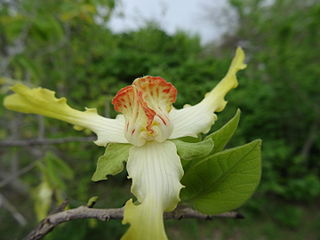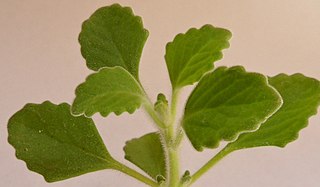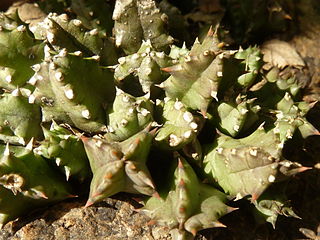
Rooibos, or Aspalathus linearis, is a broom-like member of the plant family Fabaceae that grows in South Africa's fynbos biome.

Plectranthus is a genus of about 85 species of flowering plants from the sage family, Lamiaceae, found mostly in southern and tropical Africa and Madagascar. Common names include spur-flower. Plectranthus species are herbaceous perennial plants, rarely annuals or soft-wooded shrubs, sometimes succulent; sometimes with a tuberous base.

Plectranthus verticillatus, Swedish ivy, Swedish begonia or whorled plectranthus is a plant in the family Lamiaceae (Labiatae), genus Plectranthus. Despite its common name, it is not close to the ivy family of the genus Hedera.

The orange-breasted sunbird is a species of small, predominantly nectar-feeding bird that is endemic to the fynbos shrubland biome of southwestern South Africa. It is the only member of the genus Anthobaphes, in the family Nectariniidae, though it is sometimes placed in the genus Nectarinia. The birds are sexually dimorphic, with females being olive green while the males are orange to yellow on the underside with bright green, blue and purple on the head and neck.

Artemisia afra, the African wormwood,[4] is a common species of the genus Artemisia in Africa, with a wide distribution from South Africa, to areas reaching to the North and East, as far north as Ethiopia. Artemisia afra is the only species in this genus indigenous to the African continent.

Rotheca myricoides is a species of flowering plant in the family Lamiaceae. It is native to Africa and widely cultivated elsewhere. In cultivation, it is frequently known by one of its synonyms, such as Clerodendrum myricoides.

Areas of forest which grow in KwaZulu-Natal, South Africa mostly on south facing slopes in higher rainfall areas, and along the humid coastal areas. Different types of forest can be identified by their species composition which depends mostly on the altitude, latitude and substrate in which they grow. South facing slopes are favourable for the development of forest as they are more shaded, and therefore cooler and retain more moisture than the northern slopes. The extra moisture on the south slopes is not only favoured by forest trees, but also helps to prevent or subdue wildfires. Fires can also be blocked by cliff faces and rocks or boulders on these slopes, and by streams or rivers at the base of the slopes. The coastal regions are conducive to forest formation, because of high rainfall and humidity which are favoured by forest trees and also help to prevent or subdue fires. The rivers of the coastal areas are also broader than further inland, which may often prevent fires from spreading long distances, and fires generally burn uphill and therefore more often away from areas at low altitude.

Tulbaghia violacea, known as society garlic is a species of flowering plant in the family Amaryllidaceae, indigenous to southern Africa, and reportedly naturalized in Tanzania and Mexico.

Pappea capensis is a South African tree in the family Sapindaceae. It is the only species in the genus Pappea.

Polygala myrtifolia, the myrtle-leaf milkwort, is an evergreen 2-4m tall South African shrub or small tree found along the southern and south-eastern coasts, from near Clanwilliam in the Western Cape to KwaZulu-Natal. It is a fast-growing pioneer plant, a typical fynbos component, and may be found on dunes, rocky places, along forest margins, beside streams, and in open grassland. It belongs to the milkwort family of Polygalaceae.

Coleus neochilus, synonym Plectranthus neochilus, which is colloquially known as lobster bush, fly bush or mosquito bush, is a perennial ground cover with highly fragrant, partially scalloped, ovate leaves and purple blue inflorescent spikes.

Plectranthus fruticosus, the forest spurflower, is a species of flowering plant in the mint family, Lamiaceae. It is native to Mozambique, Eswatini, and South Africa's KwaZulu-Natal, Northern, and Cape provinces. Growing up to 2 m (6.6 ft) tall, it is an erect evergreen shrub, with rounded, hairy leaves, and spikes of soft blue or mauve flowers in summer.

Monodora grandidieri is a species of plant in the family Annonaceae. It is native to Kenya, Malawi, Mozambique, Somalia, and Tanzania. Henri Ernest Baillon, the French botanist who first formally described the species, named it after the French naturalist and explorer Alfred Grandidier who collected the specimen Baillon examined. It has been reported to be used as a traditional medicine by the Giriama and Digo people of Kenya.

Plectranthus hadiensis is a perennial herbaceous plant of the family Lamiaceae.

Gardenia volkensii, commonly known as bushveldt gardenia or Transvaal gardenia, is a species of plant in the family Rubiaceae native to southern Africa.

Huernia hystrix, the porcupine huernia, is a species of flowering plant in the family Apocynaceae, native to southeastern Africa. A succulent, it has gained the Royal Horticultural Society's Award of Garden Merit.
Plectranthus purpuratus or cliff spurflower is a species of flowering plant in the family Lamiaceae, native to South Africa's Kwazulu-Natal and Mpumalanga provinces, as well as eSwatini. The name is frequently misapplied to Plectranthus ciliatus, presumably because both have purple-backed leaves.

Amandawe also known as Amandawe Mission, or often informally abbreviated as A.M.A or A.M is a small township located at KwaZulu-Natal South Coast region of South Africa, the area is mostly populated with Black Africans.

Ben-Erik van Wyk FAAS is a South African professor of indigenous botany and traditional African medicine at the University of Johannesburg.

Ceropegia ampliata is a flowering plant in the dogbane family Apocynaceae, native to South Africa, Tanzania, and Madagascar. Common names include bushman's pipe, condom plant, and horny wonder.


















